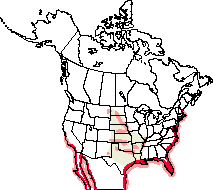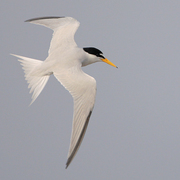Least Tern
The Washington representatives of this family can be split into two groups, or subfamilies. The adaptable gulls are the most familiar. Sociable in all seasons, they are mainly coastal, but a number of species also nest inland. Many—but not all—are found around people. Gulls have highly variable foraging techniques and diets. Terns forage in flight, swooping to catch fish or insects. They dive headfirst into the water for fish. Although they are likely to be near water, they spend less time swimming than gulls.
General Description
This highly migratory New World tern frequents estuaries, coastal lagoons, river sandbars, and sandy beaches, where it attracts attention by its tiny size and buoyant flight. The adult has a black cap, white forehead, gray mantle, white underparts, yellow legs, and black on the outer primaries. The tail is short and forked. In breeding plumage, the black-tipped yellow bill is a diagnostic field mark. Identification of terns in other plumages is less straightforward: consult a good field guide.
Least Tern has three breeding populations that have been described as distinct subspecies: along the Atlantic and Gulf Coasts from New England south through the Caribbean (S.a. antillarum); along rivers in the central United States (S.a. athalassos); and on the Pacific Coast from San Francisco Bay to western Mexico (S.a. browni). The first two populations winter from the Caribbean to Brazil, while the Pacific population winters along the coast in Mexico and Central America. The breeding populations of Least Tern in California and the interior U.S. are listed as Endangered under the federal Endangered Species Act. Least Tern nests on the ground, where it is vulnerable to predators and to human activity such as beach recreation. The California population had shrunk to 600 pairs by 1973. Protection of its nesting sites—thanks, especially, to an active management program on military installations—led to a population rebound, with 2,750 pairs recorded by 1994.
Least Terns occur very rarely in the Pacific Northwest as spring migration “overshoots,” non-breeding vagrants, or post-breeding dispersants. Oregon has about 11 records, mostly coastal, between March and mid-August. Washington’s three records are all from coastal Grays Harbor County: Ocean Shores in August 1978 and May 2005 (two birds), and Westport in May 2004. Idaho’s one accepted record is from Sandpoint in March 1988. The single record from British Columbia came at Osoyoos in June 1998.
Revised June 2007
North American Range Map


Family Members
 Laughing GullLarus atricilla
Laughing GullLarus atricilla Franklin's GullLarus pipixcan
Franklin's GullLarus pipixcan Little GullLarus minutus
Little GullLarus minutus Black-headed GullLarus ridibundus
Black-headed GullLarus ridibundus Bonaparte's GullLarus philadelphia
Bonaparte's GullLarus philadelphia Heermann's GullLarus heermanni
Heermann's GullLarus heermanni Black-tailed GullLarus crassirostris
Black-tailed GullLarus crassirostris Short-billed GullLarus canus
Short-billed GullLarus canus Ring-billed GullLarus delawarensis
Ring-billed GullLarus delawarensis California GullLarus californicus
California GullLarus californicus Herring GullLarus argentatus
Herring GullLarus argentatus Thayer's GullLarus thayeri
Thayer's GullLarus thayeri Iceland GullLarus glaucoides
Iceland GullLarus glaucoides Lesser Black-backed GullLarus fuscus
Lesser Black-backed GullLarus fuscus Slaty-backed GullLarus schistisagus
Slaty-backed GullLarus schistisagus Western GullLarus occidentalis
Western GullLarus occidentalis Glaucous-winged GullLarus glaucescens
Glaucous-winged GullLarus glaucescens Glaucous GullLarus hyperboreus
Glaucous GullLarus hyperboreus Great Black-backed GullLarus marinus
Great Black-backed GullLarus marinus Sabine's GullXema sabini
Sabine's GullXema sabini Black-legged KittiwakeRissa tridactyla
Black-legged KittiwakeRissa tridactyla Red-legged KittiwakeRissa brevirostris
Red-legged KittiwakeRissa brevirostris Ross's GullRhodostethia rosea
Ross's GullRhodostethia rosea Ivory GullPagophila eburnea
Ivory GullPagophila eburnea Least TernSternula antillarum
Least TernSternula antillarum Caspian TernHydroprogne caspia
Caspian TernHydroprogne caspia Black TernChlidonias niger
Black TernChlidonias niger Common TernSterna hirundo
Common TernSterna hirundo Arctic TernSterna paradisaea
Arctic TernSterna paradisaea Forster's TernSterna forsteri
Forster's TernSterna forsteri Elegant TernThalasseus elegans
Elegant TernThalasseus elegans

